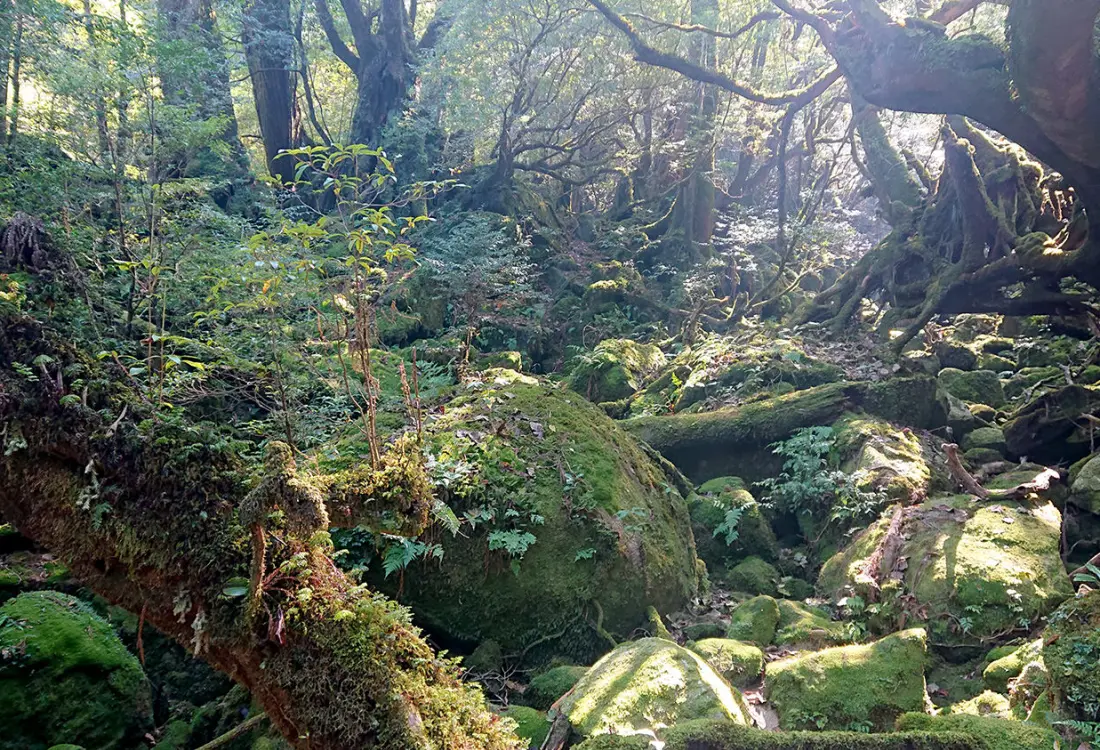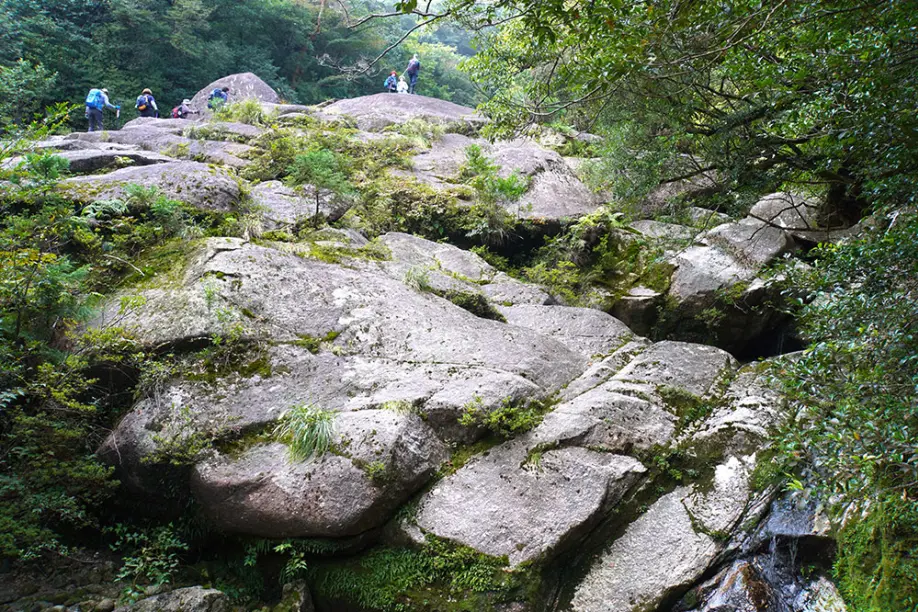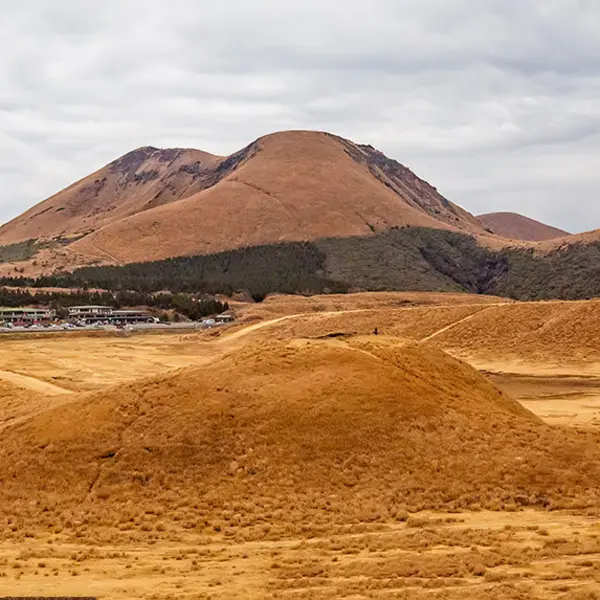
Yakushima
Trekking through Japan’s thousands-year-old forest
Nobody knows exactly how old Jomon Sugi is. Carbon-14 dates the age of this ancient Japanese cedar tree to somewhere between 2,200 and 7,200 years. Most experts agree that it’s at least a few thousand years old—indeed, from Japan’s prehistoric Jomon period. And it is still alive today. In terms of lifespan, it’s pretty close to “forever” in human years.
In Yakushima, Jomon Sugi is not alone. It may be the oldest and most famous yakusugi, but the island is home to many of these endemic Cryptomeria cedars that have lived for at least a millennium. Around 30 of them have names. So I am particularly excited to embark on a hike through the Shiratani Unsuikyo Ravine, which is one of the most scenic areas in the primeval forest, not to mention the most popular. Its exceptionally dense, moss-covered landscape of twisted trunks, sprawling roots, silent stones, and running streams is also what inspired Miyazaki Hayao’s 1997 Ghibli animated film Princess Mononoke.

After passing the Shirotaenotaki waterfall, our first mini climb is over the huge granite boulder called Ikoino Oiwa (“big resting rock”). This is a quite fitting introduction, as our guide, Steve, tells us that the geology of Yakushima island consists primarily of granite.
Some 15.5 million years ago, a tectonic plate movement caused subterranean molten granite to push through the sedimentary rock base of the island, rising steadily at about one meter every thousand years, eventually creating the island’s mountainous landscape. Yakushima’s Miyanouradake, at 1,935 meters above sea level, is the highest peak in Kyushu.
The path starts relatively flat and easy, with paving stones and steps leading the way past more waterfalls and mossy streams. The sun shines through the towering treetops, and I’m glad it’s not raining. Although Steve warns that it can be especially slippery when the rivers overflow, he also attests that this famously moss-covered forest is all the more beautiful in the rain.

Once we cross the long and narrow Satsuki suspension bridge, the mountain hike begins. Soon we arrive at the historical Kusugawa path. Steve pauses to tell us the story of this centuries-old logging trail that was once used by loggers.
During the Edo period (1603–1868), Yakushima created a buzzing local industry around the production of hiragi, wooden shingles made from yakusugi logs. The lightweight, weather-resistant hiragi were used not only as roof tiles but as a means of payment for land taxes and even commerce, supplementing the livelihoods of the islanders. Loggers would cut down the yakusugi with the straightest trunks and branches, which made the best logs for chopping and splitting into the small, smooth shingles. The Kusugawa path is the well-trodden trail they used to carry the timber and hiragi on their backs up and down the mountain.

The hiragi industry continued well into the twentieth century and accelerated drastically after chainsaws were introduced in 1956. Meanwhile, the loggers replenished the forest with kosugi, offspring of the original felled yakusugi. The reason that the forest we see today is still populated with so many ancient twisted trees is that these are the once “undesirable” yakusugi that survived that period of massive logging.

Continuing along the Kusugawa path, we walk over and under many crawling roots and tangled branches before passing through the giant split-trunk Kuguri Sugi.


Then we stumble into a log that appears to be recently chopped. It’s prohibited to chop living yakusugi since the 1970s, Steve explains, so the wood currently used to make furniture and other local souvenirs is domaiboku—deadwood that is partly buried in the ground or from the stumps of trees felled hundreds of years ago.
What makes the dead trees decompose so slowly is the same thing that allows them to live so long: their high content of juicy resin. This protects the living trees from disease in an environment of high rainfall and low soil nutrition and effectively preserves the wood from decay.

A little further up, we take a bathroom break at Shiratani Hut, which also provides tables and shelter for camping. It has running potable water, although we stop at a few pipes protruding from streams along the route, where it is just as safe to refill our water bottles.

Yakushima mountain water is absolutely pure, says Steve, with no bacteria nor added minerals. As the local government is especially mindful not to pollute the water supply, even the toilet sewage is collected and carried back down the mountain by designated workers. Shiratani Hut is situated at an altitude of 830 meters above sea level.
When we encounter Nanahon Sugi, I admire how tall and straight the tree stands, even though it now only has five branches instead of the seven suggested by its name. Its 8.3-meter circumference may be only half of Jomon Sugi’s, but it is a prime example of cohabiting generations of sugi.
Steve explains that after a typhoon, for example, when one tree falls on another, its roots can grow around what may appear to be a single trunk under the moss, and more trees can grow on top of dead stumps. This is another factor that makes it so difficult to estimate the age of living yakusugi. Nonetheless, Steve estimates Nanahon Sugi to be about 1,300 years old, with one generation around six hundred years old and another around a thousand.

At 900 meters above sea level, we stop for lunch. Steve hands us each a vintage aluminum bento box from the 1950s, filled with rice balls and other sides. By now, I’ve worked up an appetite. However, in my haste to eat, I clumsily drop a sausage into the dirt on the ground at our feet. Steve promptly offers me some water. I look at him quizzically.
“If that were me,” he says, eyeing the sausage, “I would just rinse it off with water and eat it.”
I hesitate. Steve does not. No sooner said than done, he picks up the sausage, rinses it off, and pops it into his mouth. I am impressed.
Steve explains that we shouldn’t leave anything behind in the forest, not even organic waste, and especially not food. Yakushima’s endemic wild populations of yakuzaru monkeys and yakushika deer both outnumber the island’s 12,000 human inhabitants. If these animals were to get used to eating the same food as we do, not only would our currently healthy relationship with them in the forest deteriorate, but they could end up venturing into local farmlands, with devastating results.

As we continue our climb, we spot a few macaques going about their business on either side of the path, mostly lone males. But my favorite animal encountered in the forest is the zatoumushi (harvestman), a small black arachnid with white spots and eight long thin limbs inserted into its round torso, which looks like it came straight out of another Ghibli animation.

The last stretch of our ascent is steep and winding as we make our way up through the undergrowth. As we emerge at an altitude of 1,050 meters, we are immediately rewarded with a sweeping view: Miyanouradake, Tachudake, Nagatadake, and other pilgrimage peaks with their shrines on the horizon; autumn foliage in the Arakawa valley; “skeleton trees” poking their bare limbs out of the canopy into the wind, but very much alive.

We are standing on Taikoiwa (“drum rock”), so-named because it reverberates like a drum when you tap its surface at a certain spot above an air pocket inside the stone. It has taken us almost four hours to leisurely climb our way up to this central vista point, but the way back down will go much faster. Space on the rock itself is limited, so most people tend not to linger. However, I take a few precious moments to sit down and enjoy the stillness of the view.

In 2008, Steve was standing on the deck of the ferry with his wife. After living in Tottori, they had traveled around various islands in Japan, looking for a new place to settle down and live, but so far, none had suited them. As the ferry approached its destination of Yakushima, they saw a round, lush green island in the distance. As they watched this dark green island get bigger and bigger, they exchanged not a single word but just looked at each other and smiled.
Yakushima is 90% covered in forest, one-fifth of which has been designated a natural World Heritage Site since 1993 for its exceptional biodiversity. Thanks to its wide range of altitudes from alpine to subtropical, it hosts some 1,900 species and subspecies of plants and insects, over 600 species of moss, and 23 varieties of epiphytes growing on Jomon Sugi alone.

Several hundred years ago, Yakushima was written using the Chinese character for medicine, as the Tang Dynasty monk Ganjin found that the island was a paradise for natural remedies. Today, Yakushima is written using the characters for roof and a very long time, in reference to the tiles made from its very old trees — yakusugi that, in this progressively sustainable forest, live forever.
Shiratani Unsuikyo

Ikoino Oiwa

Kusugawa logging trail

Kaminari Onji Sugi

Yakusugi deadwood

View from Taikoiwa


Cherise Fong
Originally from San Francisco, I arrived in Tokyo with my bike and my backpack one rainy day in summer. Since then, I travel through the archipelago by bicycle, train and boat, often to the rhythm of taiko and shinobue, always looking for new paths and unique perspectives.
 Hiking Matsushima Olle: Course to Explore the Nature and Intriguing History of Amakusa Island
Hiking Matsushima Olle: Course to Explore the Nature and Intriguing History of Amakusa Island Mount Aso: Nature at Its Most Majestic
Mount Aso: Nature at Its Most Majestic Yakushima: Trekking through Japan’s thousands-year-old forest
Yakushima: Trekking through Japan’s thousands-year-old forest Kikuchi District - The Great Outdoors of Kyushu
Kikuchi District - The Great Outdoors of Kyushu To Hell and Back: Walk Through the Steamy Hot Springs of Unzen
To Hell and Back: Walk Through the Steamy Hot Springs of Unzen Hiking in Ebino Highlands: Explore the Crater Lakes in the Company of Friendly Deer
Hiking in Ebino Highlands: Explore the Crater Lakes in the Company of Friendly Deer Kyushu Olle: An Autumn Hike on the Okubungo Course
Kyushu Olle: An Autumn Hike on the Okubungo Course Driving Around Fukue Island: Hidden Churches and Stunning Beaches
Driving Around Fukue Island: Hidden Churches and Stunning Beaches Hiking Trails at Aso Kusasenri
Hiking Trails at Aso Kusasenri Cape Toi in Miyazaki: A Festival of Colors
Cape Toi in Miyazaki: A Festival of Colors




